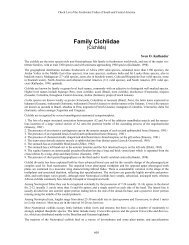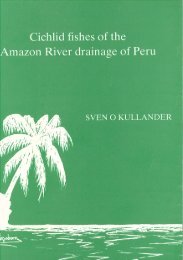Open Access PDF - Sven Kullander
Open Access PDF - Sven Kullander
Open Access PDF - Sven Kullander
You also want an ePaper? Increase the reach of your titles
YUMPU automatically turns print PDFs into web optimized ePapers that Google loves.
10°<br />
0°<br />
-10°<br />
-20°<br />
-30°<br />
-80°<br />
-70°<br />
Cichla<br />
temensis<br />
pinima<br />
vazzoleri<br />
cf. pinima 500 km<br />
-80°<br />
-70°<br />
-60°<br />
-50°<br />
-40°<br />
Fig. 75. Collecting localities of Cichla temensis, C. pinima (including translocation), C. vazzoleri, and C. cf. pinima.<br />
A symbol may cover more than one collecting site.<br />
Cichla pinima and C. vazzoleri share a distinctive<br />
adult breeding colour pattern, best expressed<br />
in males. The vertical bars become deep black<br />
and the dorsal portion of each bar may separate<br />
as a dark ocellated blotch above the upper lateral<br />
line, regularly in C. vazzoleri but rarely in<br />
C. pinima. In C. pinima the middle portion of the<br />
first bar forms a large prominent ocellus and the<br />
ventral part becomes obsolete or forms a blotch<br />
under the pectoral fin; the middle portion of bar 2<br />
may be slightly expanded and blotch-like, but<br />
usually there is a complete ocellated vertical bar<br />
extending to the abdominal side; the third bar,<br />
below the dorsal blotch, remains vertically extended,<br />
and is usually contiguous with the dorsal<br />
Ichthyol. Explor. Freshwaters, Vol. 17, No. 4<br />
-60°<br />
-50°<br />
-40°<br />
367<br />
blotch. In C. vazzoleri the pattern is similar to that<br />
of C. pinima, although the vertical bars are usually<br />
narrower, and the middle ocellus in bar 1 is<br />
not as well formed as in C. pinima.<br />
All populations sharing the development of<br />
the blotch in the dorsal portion of bar 3 were assigned<br />
to C. pinima, although samples other than<br />
those from the Tapajós and Xingu river drainages<br />
generally do not contain large breeding males<br />
in which breeding colour could be verified. Samples<br />
from southern tributaries assigned to C. pinima<br />
on the basis of colour markings turned out to<br />
be highly variable in fin ray and particularly scale<br />
counts. E1 row counts show some geographic<br />
variation and are generally higher to the west and<br />
10°<br />
0°<br />
-10°<br />
-20°<br />
-30°




